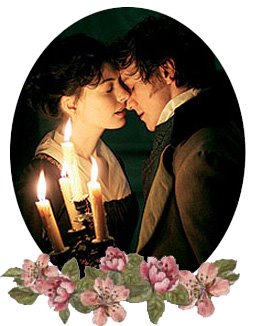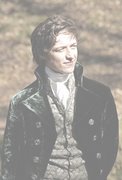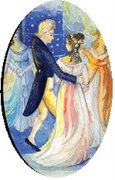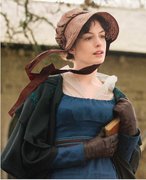Clarke’s stunning portrait of Jane Austen
 Only a week ago I wrote a post about Jane Austen’s portraits, and there I concluded that, far from the common perception of JA as a boring spinster (!), Jane Austen was actually an attractive woman and, although might not as pretty as Madam Lefroy, Eliza de Feullide or Anne Hathaway, the British author was certainly attractive enough to make men, including Tom Lefroy, fell for her.
Only a week ago I wrote a post about Jane Austen’s portraits, and there I concluded that, far from the common perception of JA as a boring spinster (!), Jane Austen was actually an attractive woman and, although might not as pretty as Madam Lefroy, Eliza de Feullide or Anne Hathaway, the British author was certainly attractive enough to make men, including Tom Lefroy, fell for her.
However, my conclusions were based on the descriptions by Jane’s family and friends and my impressions over Jane’s novels and letters, and not based on any portraits at all. For the only acknowledged image of Jane Austen so far is Cassandra’s painting of Jane, which (with all due respect to Cass) does not satisfy our curiosity of the real Jane. Jon Spence even speculated that ‘Perhaps Jane didn’t want to have her picture drawn. If she meant to sabotage the portrait, she succeeded. The picture was apparently considered unsatisfactory at the time it was done. Cassandra applied a little watercolouring to parts of the sketch and then left it unfinished. But she didn’t destroy it.’ (Spence 2003)
Hence, I was elated when I found an article and another picture of Jane Austen on the web. The charming article was written by Joan Klingel Ray and Richard James Wheeler in 2005. The picture that amazed me is this one on the right.
I’ve actually seen this picture before here, but I thought that it was ‘just’ another attempt to portray Jane Austen post-mortem. But I was surprised to learn that the painter was actually Revd. James Stanier Clarke (1765-1834), chaplain and librarian of the Prince Regent, also an acquaintance of Jane Austen that escorted her through the Prince Regent Library in Carlton House (Prince Regent’s residence in London) on Monday 13 November 1815. In another word, this painting was done by someone who knew Jane when she was still alive.
The watercolour portrait was small; only 6 ¼ inch by 3 ¾ inch, and was included in the Sacred to Friendship book written by Revd. Clarke. The 19th century book contains many drawings of celebrities e.g. novelists Charlotte Smith, plus two unidentified water-colour sketches of unidentified women. The first person to uncover the identities of the women was Richard James Wheeler, who bought the Friendship Book in a second-hand bookstore (don’t you love serendipity?). Wheeler would later elaborate his findings in his book ‘James Stanier Clarke: His Watercolour Portrait of Jane Austen Painted 13th November 1815’, published in 1998 (the book is rather expensive, £25).
With the help of the Tate Gallery, Wheeler revealed that the first woman was actually Prince Caroline of
And what about the second un-ID lady? Wheeler’s first thought was that she should be another novelist, for Clarke grouped her with novelist Charlotte Smith. After seeing Cassandra’s portrait of Jane Austen and cross-referencing descriptions of JA made by her family and friends, Wheeler found no ‘inconsistencies’ between the former references and Clarke’s portrait of the mysterious lady. Not even contradicting the statement of Rev. Fowle (brother of the deceased Thomas Fowle, Cassandra’s fiancé) re: Jane Austen: ‘certainly pretty-bright & a good deal of colour in her face-like a doll-no that would not give at all the idea for she had so much expression – she was like a child – quite a child very lively & full of humour’ (Dring 2003).
A doll. Why… that was the word that I thought about as I first saw the painting. Very lovely, a bit Japanese in style, I should say (a typical Japanese girl with cherry-hued full cheeks and a lovely smile). Thus, I did not think of Jane then.
But then, the mysterious lady was scrutinized by several ‘Austenian detectives’. For example, the dress. Ray & Wheeler say:
‘The similarities are remarkable. For example, the picture shows the figure in a white gauze gown, mostly covered by a black cape, but the gown’s décolleté neckline, dotted with black trim, is visible; its long sleeves are tucked into gloves that extend to the elbow. On
Ray & Wheeler also suggested that the lady in the painting was dressed up, and if she was Jane Austen, she would definitely dressed up at her best indeed, for she was visiting Carlton House anyway. Physiognomist Alfred Linney examined the similarities of hairstyles and face shapes between Cassandra’s and Clarke’s portraits, suggesting the resemblance between the two faces and the facial lines of the Austens, and hence Dr. Linney said that ‘there is a strong probability that they are one and the same persons’.
Another expert, medical artist Richard Neave advised that ‘Cassandra’s picture reflects many of the strong family likeliness…Clarke’s drawing is much idealized… a pretty doll like face.’ Hah. I don’t think that Neave read Revd. Fowle’s impression on Jane… who was pretty like a doll for him. By the way, the Rice painting here actually also gave the impression of a ‘pretty doll-like face’… And to me, it is very similar to Clarke's watercolour sketch of Jane Austen (Ms Place has an interesting article re: Rice portrait here).
Conclusion: Read Ray & Wheeler’s article, and if you have funding, buy Wheeler’s book, if you can find it. I certainly have voted Clarke’s painting as the most satisfying painting of Jane Austen.
By the way, James Stanier Clarke (JSC) wrote to Jane Austen on
Chapman, R. W. 1979, Jane Austen's Letters to Her Sister Cassandra and Others, 2nd edn, Oxford University Press, Oxford.
Dring, M. 2003, 'A new portrait of Jane Austen', Jane Austen's Regency World, Jan/Feb 2003, no. 1, pp. 5-9.
Ray, J. K. & Wheeler, R. J. 2005, 'James Stanier Clarke's Portrait of Jane Austen', Persuasions (printed edition), vol. 27, pp. 112-118.
Spence, J. 2003, Becoming Jane Austen, 2007, Second edn, Continuum International Publishing Group, London.
Pic 1: Jane Austen’s silhouette from the 2nd edition of
Pic 2: Sketch of Princess Caroline by Revd. Clarke, from the Artworks Gallery UK
Pic 3: The watercolour portrait of Jane Austen, painted by James Stanier Clarke in 1815, from the Artworks Gallery UK
Pic 4: Rice painting of Jane Austen from Jane Austen Society of















































3 comments:
This portrait is stunning. Its a great find Icha, thanks! In my mind this is an accurate depiction of how I imagine Jane.
Yes, I love this tiny portrait. However, because of its small size, the artist could not provide a detailed rendering of the face. The link to it also sits in the sidebar of my blog as Original Friendship Book of James Stanier Clarke, under "Original Sources".
My main problem with the Rice Portrait, which is much, much larger than the James Stanier Clarke portrait, is with the dress of the young lady. My post goes into detail about the fashions of the era. If the Rice Portrait was painted around 1788 or 1789, then the fashion is all wrong. The sash should be wider and sit lower on the torso, for fashions of those days showed a waistline. The Rice portrait did not sell at auction this past April largely because of the controversy about the painting. Provenance is not in question, but the identity of the sitter is.
In addition, if you compare Cassandra's (admittedly amateurish) portrait of Jane to a portrait of their father, one can clearly see that he and Jane are related: mouth, eyes, and nose are eerily similar. Cassandra's depiction of her sister, though stiff and wooden, is not so very far off after all.
All these portraits possess a few similarities: Jane had a short, round face and small pleasing features. Here eyes were, according to the people who knew her, the same color and shape as her father's, and in these portraits they gaze out confidently. In addition to a pretty face, she presented a neat figure. I imagine she was petite and quite lovely to those who knew her.
Yes... she would be this petite woman; a lovely little lady with her witty smile and kind heart...
Ah, but I've written an article in response to your problem with Rice Portrait, Ms Place dear. I shall post it tomorrow, I hope, once I'm done with Lefroy (for a moment... you don't know how stubborn he is...)
Post a Comment